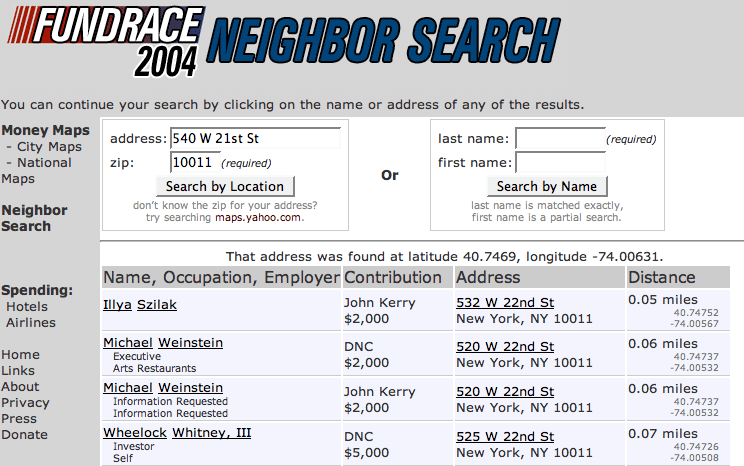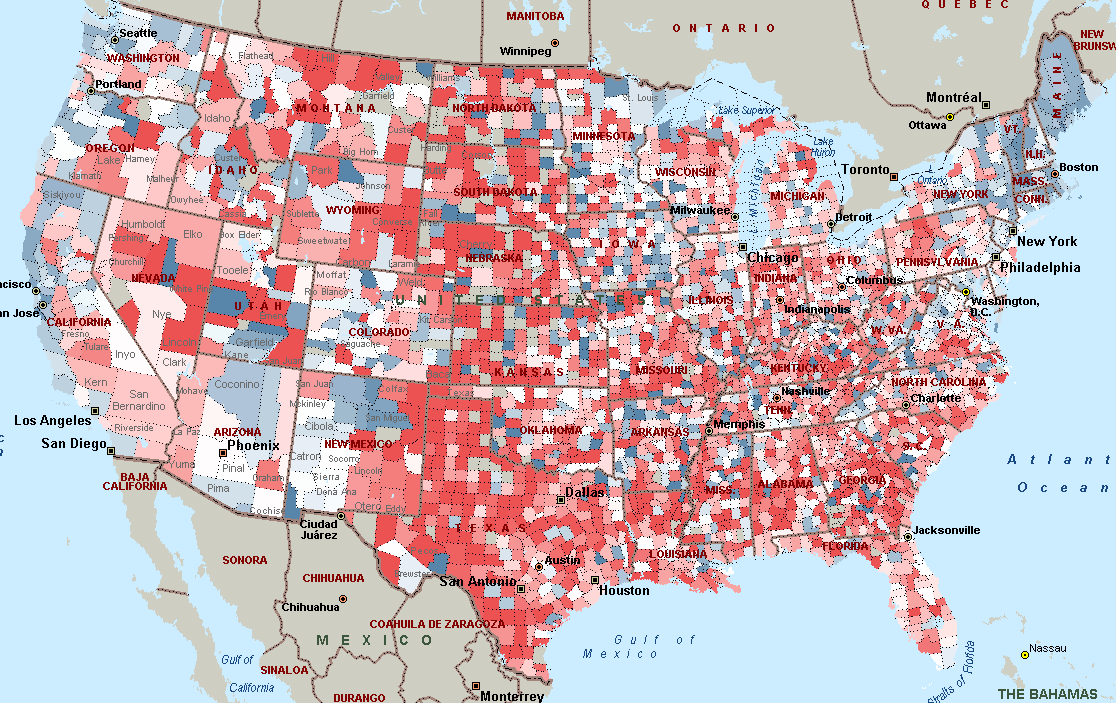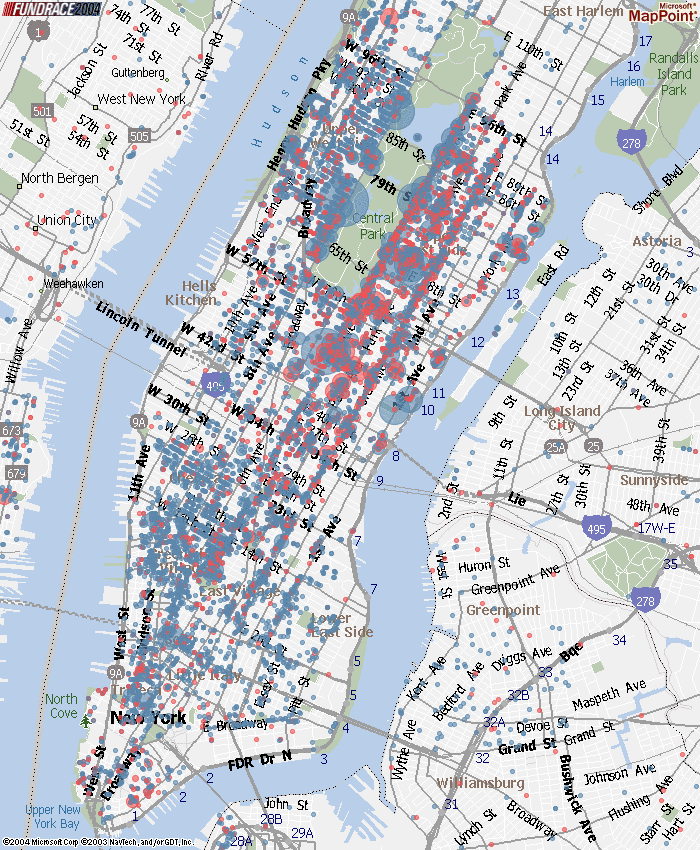Hack 16. Who Are the Neighbors Voting For?


Fundrace can show you which political candidates and parties have the most support in your areaand which of your neighbors are supporting them.
The financial machinations of presidential election campaigns are not as distant, highbrow, or incomprehensible as one might think, and the web site http://www.fundrace.org/ will show you why. Enter your address and ZIP Code into its Neighbor Search, as shown in Figure 2-8, and you are immediately provided with a vista of the political landscape of your neighborhood. By aggregating and geocoding campaign contribution records, Fundrace allows you to uncover a little more about the pocket depth and political sentiment of your friends, coworkers, relatives, and neighbors.
Figure 2-8. A Fundrace Neighbor Search

Fundrace is the result of questions asked and hacks committed by researchers working at Eyebeam (http://eyebeam.org/), a nonprofit, nonpartisan arts and technology organization in New York City. Fundrace is built on a database of presidential campaign finance records published by the United States Federal Election Commission (FEC). These records include the amount and date of each contribution totaling over $200, along with the name, mailing address, occupation, and employer of the corresponding contributor. With individual contributions to campaigns capped at $2,000, and campaigns raising tens of millions of dollars at a stroke, this amounts to a fair heap of information for anyone to try to interpret meaningfully.
In the autumn of 2003, the financing of the presidential primary campaigns, especially those using grassroots fundraising over the Web, was a prevalent topic in the national media. The content and presentation style of other existing campaign finance web sites, such as http://www.opensecrets.org/ and http://www.fecinfo.com/, did not seem likely to attract the attention of anyone who wasn't actively seeking out this information already. The first iteration of Fundrace consisted of a number of simple statistical rankings and a handful of national fundraising maps, intended to help people draw some distinctions among the wide field of candidates running at the time.
Despite offering a modicum of satire, Fundrace 1.0 didn't reach much further than other sites of a similar nature. By far, the most popular feature of the initial experiment was the national red-versus-blue Money Map (Figure 2-9), in which each county was shaded either red or blue, depending on whether Republicans or Democrats had raised more money there, respectively.
Figure 2-9. A Money Map of the United States, Democrats versus Republicans, by county

Figure 2-10. A Fundrace map of Manhattan

The next step in the right direction came when a Bostonian monthly magazine of some repute asked to publish one of Fundrace's maps. They liked the national red-versus-blue but were also interested in something a little more localized. Finally, it became time to geocode the data. After cleaning up the messier street addresses [Hack #81], Fundrace used MapPoint to plot contributions onto what is probably the most recognized several-miles-square chunk of land on Earth: Manhattan. Aggregating by individual building, as shown in Figure 2-10, while maintaining the red-versus-blue coloring convention, produced an immediately intuitive and stark picture of sociopolitical geography .
What quickly became clear upon making this map of New York was that this data could serve as a lens not only for viewing the different candidates but for looking at the world in general. It also became clear that the principle of locality was as applicable as ever. People are most interested in the data that is physically nearest to them. Thus was born the Fundrace Neighbor Search. With contributors' addresses already geocoded, it was a simple matter of geocoding the query address and sorting by Euclidean distance to find the user's closest contributing neighbors.
As they say, the rest is history. The idea, and its results, were so compelling that within only a couple of days of launching the Neighbor Search and city-level Money Maps, Fundrace.org was an extremely hot web site. Web logs couldn't link fast enough, the site was receiving an onslaught of traffic, and the national media was knocking down our door. From all channels, the feedback Fundrace received covered a broad range of opinions. We received many emails thanking us for the valuable public service performed by the site. We also received numerous requests, none honored, to remove records from our database.
Some people were shocked to discover the political leanings of their friends or relatives. Others were embarrassed to know that their whole office could see whose campaign they had contributed to. The occasional amateur watchdog contacted Fundrace about perceived violations of campaign finance law, and a number of academics, hackers, and GIS professionals requested a copy of our database for their own exploration.
Probably the most contentious aspect of Fundrace was the fact that it revealed the home addresses of contributors. Many considered this a serious threat to personal privacy, but there already existed a number of web sites (including the FEC's) where the same information, as part of the public record, could be obtained. Fundrace is of the opinion that the more people who become aware of the public nature of this information, the better. At the very least, if a large enough constituency of voters were to decide that the risks outweigh the benefits, the FEC's policy could be changed.
In the United States of America there exists a tradition of public access to certain kinds of government records. This access is rooted in the principle of government accountability, a necessary feature of any legitimate democracy. The tradition has, of late, been reinforced by so-called Freedom of Information Legislation (FOIL), and by the ease of disseminating such information via the Internet. Despite this trend, the average citizen still seems largely unable make good use of FOIL and the Internet to understand and participate in his own government. Officially published data and documents are often disorganized, poorly documented, or simply too voluminous to handle with limited skills and resources. Fortunately, this leaves plenty of room for hackers like us, and organizations such as Eyebeam, to do lots of interesting and relevant work.
Fundrace is a proof positive example that abstruse government data can excite and engage people, and that all it takes is a few good hacks.
Michael Frumin
Mapping Your Life
- Hacks 1-13
- Hack 1. Put a Map on It: Mapping Arbitrary Locations with Online Services
- Hack 2. Route Planning Online
- Hack 3. Map the Places Youve Visited
- Hack 4. Find Your House on an Aerial Photograph
- Hack 5. The Road Less Traveled by in MapQuest
- Hack 6. Make Route Maps Easier to Read
- Hack 7. Will the Kids Barf?
- Hack 8. Publish Maps of Your Photos on the Web
- Hack 9. Track the Friendly Skies with Sherlock
- Hack 10. Georeference Digital Photos
- Hack 11. How Far? How Fast? Geo-Enabling Your Spreadsheet
- Hack 12. Create a Distance Grid in Excel
- Hack 13. Add Maps to Excel Spreadsheets with MapPoint
Mapping Your Neighborhood
- Hacks 14-21
- Hack 14. Make Free Maps of the United States Online
- Hack 15. Zoom Right In on Your Neighborhood
- Hack 16. Who Are the Neighbors Voting For?
- Hack 17. Map Nearby Wi-Fi Hotspots
- Hack 18. Why You Cant Watch Broadcast TV
- Hack 19. Analyze Elevation Profiles for Wireless Community Networks
- Hack 20. Make 3-D Raytraced Terrain Models
- Hack 21. Map Health Code Violations with RDFMapper
Mapping Your World
- Hacks 22-34
- Hack 22. Digging to China
- Hack 23. Explore David Rumseys Historical Maps
- Hack 24. Explore a 3-D Model of the Entire World
- Hack 25. Work with Multiple Lat/Long Formats
- Hack 26. Work with Different Coordinate Systems
- Hack 27. Calculate the Distance Between Points on the Earths Surface
- Hack 28. Experiment with Different Cartographic Projections
- Hack 29. Plot Arbitrary Points on a World Map
- Hack 30. Plot a Great Circle on a Flat Map
- Hack 31. Plot Dymaxion Maps in Perl
- Hack 32. Hack on Base Maps in Your Favorite Image Editor
- Hack 33. Georeference an Arbitrary Tourist Map
- Hack 34. Map Other Planets
Mapping (on) the Web
- Hacks 35-46
- Hack 35. Search Local, Find Global
- Hack 36. Shorten Online Map URLs
- Hack 37. Tweak the Look and Feel of Web Maps
- Hack 38. Add Location to Weblogs and RSS Feeds
- Hack 39. View Your Photo Thumbnails on a Flash Map
- Hack 40. Plot Points on a Spinning Globe Applet
- Hack 41. Plot Points on an Interactive Map Using DHTML
- Hack 42. Map Your Tracklogs on the Web
- Hack 43. Map Earthquakes in (Nearly) Real Time
- Hack 44. Plot Statistics Against Shapes
- Hack 45. Extract a Spatial Model from Wikipedia
- Hack 46. Map Global Weather Conditions
Mapping with Gadgets
- Hacks 47-63
- How GPS Works
- Hack 47. Get Maps on Your Mobile Phone
- Hack 48. Accessorize Your GPS
- Hack 49. Get Your Tracklogs in Windows or Linux
- Hack 50. The Serial Port to USB Conundrum
- Hack 51. Speak in Geotongues: GPSBabel to the Rescue
- Hack 52. Show Your Waypoints on Aerial Photos with Terrabrowser
- Hack 53. Visualize Your Tracks in Three Dimensions
- Hack 54. Create Your Own Maps for a Garmin GPS
- Hack 55. Use Your Track Memory as a GPS Base Map
- Hack 56. Animate Your Tracklogs
- Hack 57. Connect to Your GPS from Multiple Applications
- Hack 58. Dont Lose Your Tracklogs!
- Hack 59. Geocode Your Voice Recordings and Other Media
- Hack 60. Improve the Accuracy of Your GPS with Differential GPS
- Hack 61. Build a Map of Local GSM Cells
- Hack 62. Build a Car Computer
- Hack 63. Build Your Own Car Navigation System with GpsDrive
Mapping on Your Desktop
- Hacks 64-77
- Hack 64. Mapping Local Areas of Interest with Quantum GIS
- Hack 65. Extract Data from Maps with Manifold
- Hack 66. Java-Based Desktop Mapping with Openmap
- Hack 67. Seamless Data Download from the USGS
- Hack 68. Convert Geospatial Data Between Different Formats
- Hack 69. Find Your Way Around GRASS
- Hack 70. Import Your GPS Waypoints and Tracklogs into GRASS
- Hack 71. Turn Your Tracklogs into ESRI Shapefiles
- Hack 72. Add Relief to Your Topographic Maps
- Hack 73. Make Your Own Contour Maps
- Hack 74. Plot Wireless Network Viewsheds with GRASS
- Hack 75. Share Your GRASS Maps with the World
- Hack 76. Explore the Effects of Global Warming
- Conclusion
- Hack 77. Become a GRASS Ninja
Names and Places
- Hacks 78-86
- Hack 78. What to Do if Your Government Is Hoarding Geographic Data
- Hack 79. Geocode a U.S. Street Address
- Hack 80. Automatically Geocode U.S. Addresses
- Hack 81. Clean Up U.S. Addresses
- Hack 82. Find Nearby Things Using U.S. ZIP Codes
- Hack 83. Map Numerical Data the Easy Way
- Hack 84. Build a Free World Gazetteer
- Hack 85. Geocode U.S. Locations with the GNIS
- Hack 86. Track a Package Across the U.S.
Building the Geospatial Web
- Hacks 87-92
- Hack 87. Build a Spatially Indexed Data Store
- Hack 88. Load Your Waypoints into a Spatial Database
- Hack 89. Publish Your Geodata to the Web with GeoServer
- Hack 90. Crawl the Geospatial Web with RedSpider
- Hack 91. Build Interactive Web-Based Map Applications
- Hack 92. Map Wardriving (and other!) Data with MapServer
Mapping with Other People
- Hacks 93-100
- Hack 93. Node Runner
- Hack 94. Geo-Warchalking with 2-D Barcodes
- Hack 95. Model Interactive Spaces
- Hack 96. Share Geo-Photos on the Web
- Hack 97. Set Up an OpenGuide for Your Hometown
- Hack 98. Give Your Great-Great-Grandfather a GPS
- Hack 99. Map Your Friend-of-a-Friend Network
- Hack 100. Map Imaginary Places
EAN: 2147483647
Pages: 172
